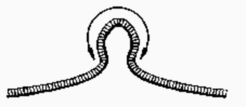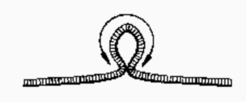Tissue evagination and the generation of biological form
Morphogenesis proper involves the generation of real form with spatial patterns of curvature. An elementary process is the evagination of an originally nearly flat cell sheet. Often processes of this type, such as bud formation in Hydra, exhibit impressive self-regulatory features, rendering the form produced robust against interferences and distortions, corresponding to an approach to a stable steady state. Cell sheets require non-linear cell interactions to be stable, avoiding clumping as well as decay, and the cells are polar, with different inside and outside surfaces.
These conditions being met, the activation of an area of the cell sheet (double arrow) by a morphogenetic field is expected to affect intracellular and intercellular processes in an asymmetric manner with respect to inner and outer parts of the sheet, thus leading to bending moments, curvature and evagination. Shell theory, as used in architecture to account for the interplay of curvature in the surface dimensions has been applied to models for evagination of rotationally symmetric structures (Gierer, 1977b, 1981a ).



Further Reading and References
Gierer, A (1977b). Physical aspects of tissue evagination and biological form. Quarterly Rev. Biophys. 10, 529-593.
Gierer, A (1981a). Generation of biological patterns and form: Some physical, mathematical, and logical aspects. Prog. Biophys. molec. Biol. 37, 1-47. [PDF]


